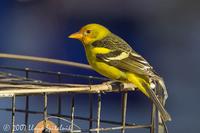Western Tanager (male) photo - Lloyd Spitalnik photos at pbase.com
>
Western Tanager (male)
previous
next
21-FEB-2007
Lloyd Spitalnik
Western Tanager (male)
Baldwin , NY
Piranga ludoviciana
Western Tanagers are very rare visitors to NYS. Their normal winter range is Northern Mexico to Costa Rica, yet this bird has survived an unusually cold winter on Long Island. A big thank you to the homeowners who graciously welcomed birders to view the tanager and many other birds at their backyard feeders!
Canon EOS 1D Mark II |

